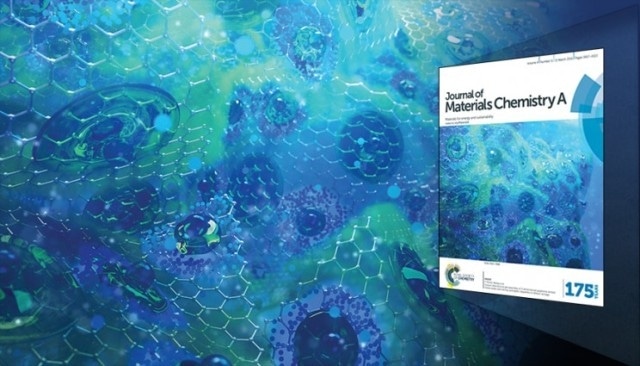Mar 23 2016
Some metal oxides can increase capacity and optimize the cycling performance of lithium-ion batteries, according to material scientists at Lawrence Livermore National Laboratory (LLNL). They produced three graphene metal oxide (GMO) nanocomposites and compared their electrochemical performance. What they determined was two of the nanocomposites were able to significantly improve reversible lithium storage capacity.
 This schematic illustration shows metal oxides tented inside graphene. Many metal oxide/graphene composites offer unexpected capacity synergy that helps to increase storage capacity. (Image by Ryan Chen/LLNL.)
This schematic illustration shows metal oxides tented inside graphene. Many metal oxide/graphene composites offer unexpected capacity synergy that helps to increase storage capacity. (Image by Ryan Chen/LLNL.)
The study results have appeared on the cover of the March 21 edition of the Journal of Materials Chemistry A. GMO nanocomposites are recognized as a potential candidate to use for energy storage and conversion applications, such as lithium-ion batteries, capacitors, sensors, and as catalysts for air cleaning, water splitting and fuel cells.
For lithium-ion battery applications, metal oxide (MO) nanoparticles and highly conductive graphene are believed to provide benefits to minimize polarization in the electrode and shorten lithium diffusion pathways, resulting in improved performance.
In the analysis prefabricated graphene aerogel electrodes were immersed in metal ion solutions, where all of the metal oxide nanoparticles are attached to the graphene surface and are completely accessible to the electrolyte, i.e. open pore space.
In essence, our approach helps to optimize the system-level performance by ensuring that most metal oxides are active.
Morris Wang, Material Scientist, LLNL
Most types of MOs can be deposited onto the same prefabricated 3D graphene structure using this method, enabling the electrochemical performance of different GMOs to be compared directly.
We found that the experiments showed large reversible lithium storage capacities of graphene sheets, enabled by the unheralded roles of metal oxides. Surprisingly, we saw the magnitude of capacity contributions from graphene is mainly determined by active materials and the type of MO bound onto the graphene surface.
Morris Wang, Material Scientist, LLNL
Graphene capacity contributions can be determined with the help of the MOs’ lithium storage mechanisms and their loading ratio against graphene.
Jianchao Ye, Yonghao An, Elizabeth Montalvo, Patrick Campbell, Marcus Worsley, Ich Tran, Yuanyue Liu, Brandon Wood and Juergen Biener are the other Livermore scientists contributed to the research. The work received funding from the Laboratory’s Research and Development.